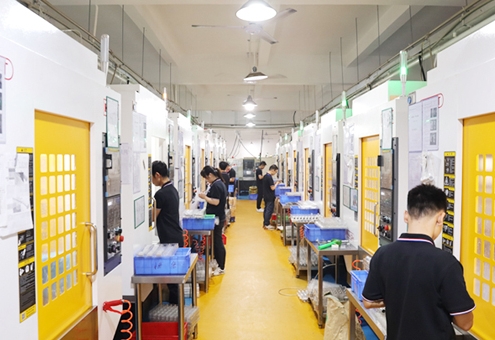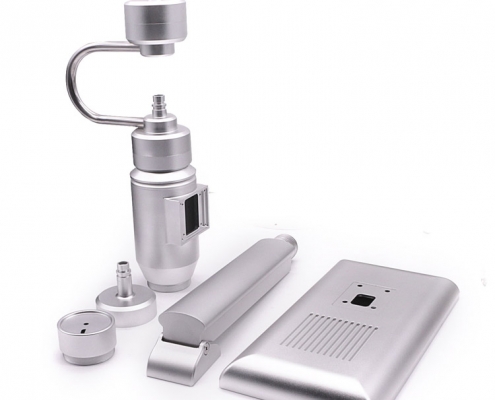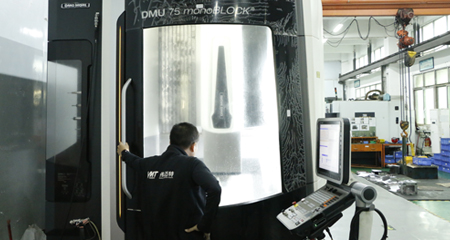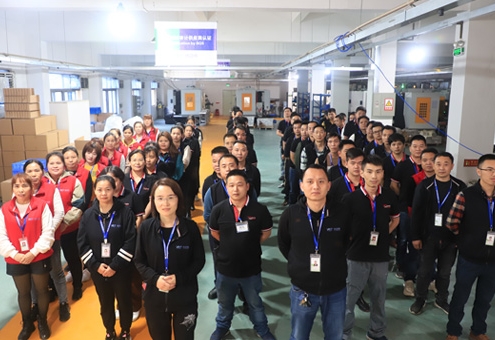Top 10 CNC Machines : A Comprehensive Guide
Selecting the appropriate CNC machine is essential for achieving high-quality and precise manufacturing outcomes. Utilizing an incorrect machine can result in substantial production delays and setbacks.Choosing the right CNC machine enhances both quality and efficiency in manufacturing processes. This guide offers a comprehensive overview of the top 10 CNC machines utilized across diverse applications in precision machining, highlighting their key features and specifications.Let us read on to explore each CNC machine’s unique strengths and uses.
Top CNC Machines Overview
There are many types of CNC machines on the market, each with its own specific features and uses. This article is designed to help you choose the most suitable CNC machine for your manufacturing needs. The following is a detailed description of the performance, accuracy, and application areas of some of the top CNC machines currently on the market.
1. CNC Milling Machine
CNC milling machines are recognized for their versatility and suitability for intricate cuts, frequently employed in industries such as automotive and aerospace. Their capacity to execute complex tasks—including drilling, boring, and contouring—renders them essential components of contemporary manufacturing processes. These machines employ rotary cutters to eliminate material from a workpiece, facilitating the creation of precise shapes and dimensions. Moreover, advanced CNC milling machines are capable of being programmed for multi-axis operations, which significantly enhances their functionality for intricate designs and complex geometries. With a reputation for precision and adaptability, CNC milling machines are proficient in managing a wide range of materials, from metals to plastics, while consistently producing high-quality finishes that are particularly advantageous in the automotive and aerospace manufacturing sectors.
2. CNC Lathe
CNC lathes excel in creating cylindrical parts, crucial for industries that require rotationally symmetric components. These machines rotate the workpiece against a stationary cutting tool, allowing for the precise shaping of materials into components such as shafts, gears, and fittings. The automation of CNC lathes enhances production speed and consistency, making them a preferred choice for mass production. With features such as live tooling and sub-spindles, modern CNC lathes can perform multiple operations, reducing setup times and increasing efficiency. CNC lathes provide exceptional precision and efficiency for producing components like shafts and fittings. Common in automotive and manufacturing, these lathes allow for accurate, high-speed rotations for parts needing uniformity.
3. CNC Router
CNC routers are adept at managing larger sheet materials such as wood, plastic, and soft metals, making them essential tools in woodworking and signage production. They function similarly to CNC milling machines but are specifically engineered for cutting, carving, and engraving on flat surfaces. CNC routers can achieve impressive speeds while producing intricate designs, rendering them ideal for applications that necessitate detailed artwork or complex cuts. Their versatility allows them to be employed across a variety of industries, including furniture manufacturing, custom cabinetry, and decorative arts. Known for their efficiency and precision, CNC routers excel in large-scale cutting and engraving tasks, contributing to their popularity in producing furniture, signage, and ornamental items.
4. CNC Plasma Cutter
Plasma cutters are robust tools designed for cutting conductive metals and are extensively utilized in the metal fabrication and automotive industries. These machines operate by employing a high-velocity jet of ionized gas to melt and effectively cut through metal, resulting in clean and precise cuts at impressive speeds. Capable of producing complex shapes and intricate designs, plasma cutters are vital components in workshops focused on metal fabrication. Known for their efficiency, these machines deliver clean cuts, making them ideal for high-speed metalworking tasks, especially in metals such as steel and aluminum.
5. CNC Waterjet Cutter
Waterjet cutters utilize high-pressure water, often combined with abrasives, to cut through various materials without generating heat, which ensures materials remain unaltered and prevents thermal distortion—particularly beneficial for sensitive materials like glass and composites. CNC waterjet cutters are versatile, handling different thicknesses and types of materials, from metals to plastics. The precision of waterjet cutting makes it a favored option for industries demanding intricate designs with minimal material waste, making it ideal for applications like cutting stone and composites.
6. CNC Laser Cutter
CNC laser cutters achieve precise cuts in metals, plastics, and other materials with minimal waste, making them ideal for high-detail projects. They use a focused laser beam to melt or vaporize material, allowing for clean and intricate cuts. The speed and precision of laser cutters have led to their widespread use in industries such as electronics and jewelry, where detail is essential. The ability to cut various materials with a single machine significantly enhances operational efficiency, making laser cutters invaluable in any fabrication shop.
7. CNC EDM (Electrical Discharge Machine)
CNC EDMs specialize in hard metals, making them perfect for intricate details in mold-making and aerospace parts. This process uses electrical discharges to remove material, enabling precise cuts and shapes even in tough materials like titanium and carbide.CNC EDMs are especially beneficial for creating complex geometries and fine details difficult to achieve with traditional machining methods. Tool and die shops often rely on EDMs for their unmatched accuracy with intricate designs.
8. CNC 3D Printer
CNC 3D printers enable additive manufacturing by creating prototypes and complex shapes in fields like medical devices. These machines build objects layer by layer from digital models, allowing rapid production of intricate designs. The versatility of 3D printing technology is ideal for prototyping, small batch production, and custom parts manufacturing. With advancements in materials and printing technology, CNC 3D printers are increasingly relevant in industries like healthcare and aerospace.
9. 5-axis CNC Machine
The five-axis CNC machine is an excellent choice for high-precision manufacturing, especially in processing complex curved surfaces. This machine features a stable operating platform and a high-rigidity structure, ideal for high-end industries like aviation and medicine. Its advanced capabilities allow for machining intricate contours, making it essential for applications demanding exceptional accuracy and detail.
10. CNC Multi-Tasking Machine
CNC multi-tasking machines integrate milling, turning, and additional operations, maximizing efficiency for complex manufacturing projects. These advanced machines allow multiple processes within a single setup, reducing processing time and enhancing workflow efficiency. Multi-tasking machines are advantageous in high-mix, low-volume manufacturing environments where efficiency and precision are crucial.By consolidating multiple operations, they are ideal for high-complexity manufacturing, contributing to improved workflows and versatility.
What Are the Strengths of a CNC Machine?
A CNC machine boasts several key strengths that make it indispensable in modern manufacturing. Here are the advantages of a CNC machine:
High Precision:
CNC machines utilize digital control systems to achieve exceptionally high processing accuracy and stability, enabling the production of more precise and dimensionally accurate components.
High Efficiency:
CNC machines are controlled by computer programs, capable of automatically completing complex processing tasks, significantly boosting production efficiency. Compared to traditional manual machines, CNC machines offer faster processing speeds and shorter production cycles.
Flexibility:
CNC machines can quickly adjust processing programs according to different processing needs, facilitating the conversion between various processing methods. They to adapt to a wide range of complex processing tasks.
High Degree of Automation:
CNC machines can achieve fully automated production processes, reducing manual intervention and labor intensity. This not only increases production efficiency but also lowers production costs.
How to Use a CNC Machine Step by Step?
- Understand the CNC Machine Components
Familiarize yourself with the CNC machine’s main parts: the controller (interprets G-code), spindle (holds the cutting tool), table (supports the workpiece), and the axes (X, Y, and Z movements). Understanding these components is essential for effective operation. - Prepare the Design
Create a detailed part design using CAD (Computer-Aided Design) software. Ensure it meets specifications and export it in a compatible format like DXF or STL for generating machining instructions. - Generate G-Code
Import your CAD design into CAM (Computer-Aided Manufacturing) software to create G-code. Define tool paths, cutting speeds, and feed rates, and post-process the design to convert it into G-code. - Set Up the CNC Machine
Choose the appropriate cutting tool and install it in the spindle. Load the workpiece onto the CNC table, using clamps or vises to secure it. - Configure the Machine
Power on the CNC machine and set the work offsets. Run a dry test to verify the tool path and machine operation, preventing errors during the actual process. - Run the CNC Program
Load the G-code and start the machining process, monitoring the operation closely. - Post-Processing
Remove the finished part and deburr any sharp edges. Inspect the part for quality. - Maintain the CNC Machine
Perform regular maintenance, cleaning, and lubrication. Check and calibrate periodically to ensure accurate performance.
In Conclusion
The top ten CNC machine tools demonstrate their extraordinary strengths, including excellent performance, high precision, durability, and user satisfaction. Given the variety of choices, it’s recommended to carefully consider your needs and budget to select the CNC machine that best suits your requirements.
Choose VMT for CNC machining, you will enjoy a one-stop high-quality solution. We are equipped with a total of 66 high-precision CNC machine tools including 3-axis, 4-axis, and 5-axis, as well as 30 CNC lathes and 20 automatic lathes, ensuring that whether it is complex and precise parts or large-scale standard parts production, we can easily meet your diverse processing needs. Contact us now!
Frequently Asked Questions About CNC Machines
What Is CNC Precision Machining?
CNC precision machining refers to the use of computer numerical control technology to achieve precise control over the cutting tools and other processing tools, thereby achieving high-precision processing of workpiece materials. This technology can meet the strict requirements for dimensional accuracy, shape accuracy, and surface accuracy of parts.
What Is a CNC Router?
A CNC router is a computer-controlled cutting machine that uses a rotating tool to precisely shape materials like wood, plastic, and metal according to programmed designs.







